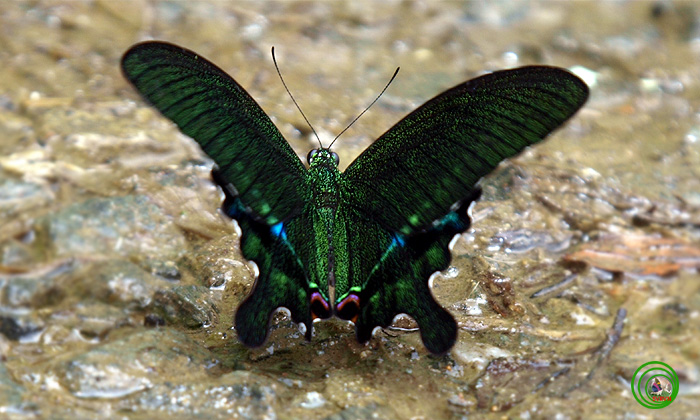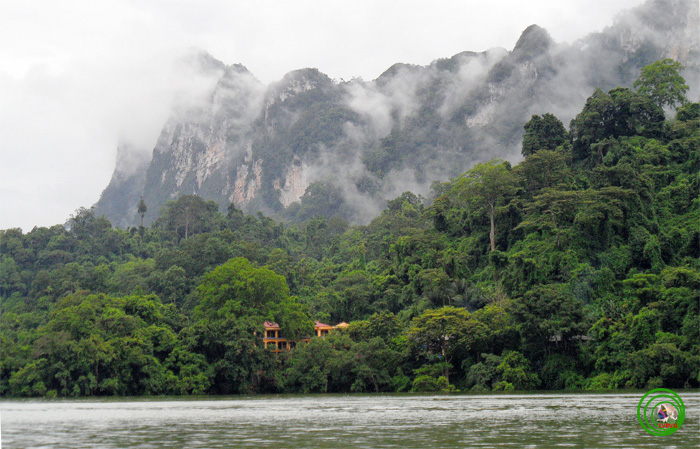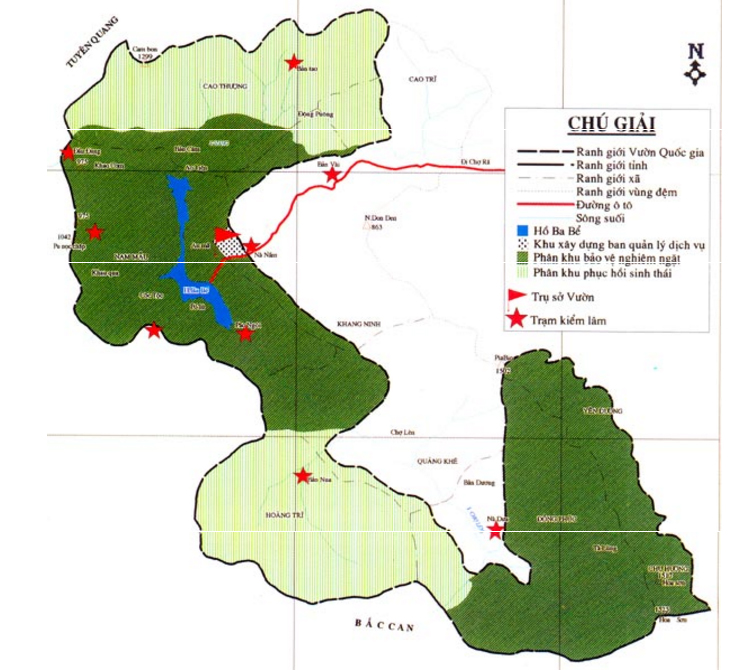|
BA BE NATIONAL PARK
Translate into English by Ngô Thị Dung
Ba Be National Park is located in Ba Be district in Bac Kan province. The Park was created by decision No. 83/TTg 11/10/1992 with boundaries established as follows: the Park is bordered on the north by the Cao Thuong commune and on the west by the Quang Khe, Nam Cuong, and Xuan Lac communes and on the south by the Quang Khe commune, and on the east by Cao Tri and Khang Ninh communes.
It is located at 105o36'E 22o30'N, with a total area of 7.610 ha (76.1 km2). It has an approximately 42.100ha (421 km2) buffer zone, which includes all streams flowing into the lake of Ba Be.
Objectives and tasks: To conserve natural ecosystems, To conserve genetic resources of valuable plants and animals on land and in water in their natural landscapes, To restore natural forest ecosystems, and. To perform scientific research, to preserve a site for tourism and to educate the public about conservation.
Agency / management: The park is managed by the provincial People's Committee of Bac Kan. The park has its own management board of 65 forestry management staff.
|

|
|
| |
Paris peacock swallowtail - Papilio paris - Picture: Phung My Trung |
|
The value of biodiversity
Plants:
Ba Be National Park has 1,281 species of plants belonging in 162 families and 672 genera, including many rare and valuable plant species that have been recorded in the Red Data Book of Vietnam and the Red Book of the World.
The park includes rare and valuable tree species such as:
Nghiến - Burretiodendron tonkinense, Đinh - Markhamia stipulata, Lim - Erythrophloeum fordii, Trắc dây - Dalbergia sp, etc.For example, Dalbergia sp is an endemic species of bamboo of Ba Be, and the trees usually grow on the steep cliffs of the lake, and their branches droop into the lake creating curtains around the lake. Domestic and foreign scientists have determined that Ba Be has a concentration of the greatest diversity of species of the Orchidaceae family, not only in Vietnam, but also in the entire Southeast Asian region. Ba Be contains 182 species of orchids, and some orchids are indigenous, found only in Ba Be. Animals:
The fauna is very diverse, with 81 species of mammals, 27 species of reptiles, 17 species of amphibians, 322 species of birds, 106 species of fish, and 553 species of insects and spiders. Many of these species that are rare and valuable have been recorded in the Red Data Book of Vietnam and the Red Book of the World.
Regarding fish fauna, Ba Be Lake and it surrounding rivers and streams have 106 species of fish, which have been identified as the most abundant in Vietnam. By comparison, Lac Lake has only 35 species, Tay Lake has 36 species, Chau Truc Lake has 47 species, etc. Ba Be National Park also has a very important role in the preservation of a number of species which are threatened globally such as Voọc đen má trắng Trachypithecus francoisi và Cầy vằn bắc Hemigalus owstoni, and only a few number of Trachypithecus francoisi currently exist in the area.
322 species of birds have been recorded in recent surveys in the National Park. Some species of the Ba Be bird populations are endangered; seven species of the subtropical Sino-Himalayan forest which are banned from exploitation include: Cắt nhỏ bụng trắng - Microhierax melanoleucos, Dẻ cùi vàng - Kitta flavirostris, Hoét ngực đen - Turdus dissimilis, Bông lau trung quốc - Pycnonotus sinensis, Cành cạch đen -Hypsipetes leucocephalus, Cành cạch núi - Hypsipetes macclellandi, Sáo đá đuôi ngắn - Sturnus malabarica.
Six threatened species in the Dong Duong Wet Rainforest include: Gà tiền mặt vàng, Thầy chùa đít đỏ, Đớp ruồi Hải Nam, Cành cạch nhỏ, Khướu bạc má, Khướu khoang cổ.
|

|
|
| |
A part of Ba Be National park, Picture: Nguyen Trong Hiep |
|
Three threatened species in Tropical Dry Indo-Malays Zone are Thầy chùa bụng nâu Megalaima lineata, Chim khách Crypsirina temia,
Bông lau tai trắng Pycnonotus blanfordi
Bird populations found in the green forest, secondary forest and inhabited areas are quite different in species composition. Raptors found in the surveys are relatively diverse with the presence of six diurnal species and three nocturnal species such as Diều ăn ong - Pernis ptilorhychus, Diều hoa - Spilornis cheela, Ưng xám - Accipiter badius, Cắt nhỏ bụng trắng- Microhierax melanoleucos, Cắt lưng hung - Falco tinnunlus, Cú vọ - Glaucidium cuculoides, Cú vọ mặt trắng - Glaucidium brodiei, Cú mèo latusơ - Otus spilocephalus lutouchei
The abundance of raptors in Ba Be indicates that environmental conditions of the Ba Be study area are good. However, there are two species of endangered birds which have disappeared from the region, which are Hồng hoàng Buceros bicornis và Diều cá đầu xám Icthyophaga icthyaetus
There are 44 species of reptiles and amphibians which are in the list of protected species which have been found in the National Park in the recent surveys, and include rare and valuable species, such as Gekco - Gekko gecko,Ô rô vẩy Acanthosaura lepidogaster Rắn sọc đuôi khoanh Orthriophis moellendorffii, Rồng đất Physignathus cocincinus.
Tourism: There are many different types of tourism such as ecotourism, traditional tourism and adventure tourism. Ba Be offers many tourist routes with spectacular scenery like caves, rivers, waterfalls, etc. According to statistics from 1999 and 2000, there were approximately 20,000 visitors in Ba Be National Park each year. Ba Be is a clear area that shows the historical imprint of the formation period of the earth's crust in both landscape and geology. In geomorphology, Ba Be is a large ancient limestone region that is 450 million years old with very distinct characteristics.
Ba Be features an amazing phenomenon where in the process of geological change, the limestone turned into marble plaques. According to geologists, limestone rarely becomes marble. Further, Ba Be is marvelous in that there is a large lake between limestone areas. A thick layer of clay 200 meters deep sealed the lake bottom. This clay layer prevented water from draining, and therefore the lake was formed. Ba Be means "three lakes", the Tay people called it "Slam Pe" (the Pé Leng, Pe Lu, and Pe Lam Lakes). Ba Be is an ancient name to say that the lake has three relatively large bulging sections. However, Ba Be is a stable lake with numerous small streams, stretching nearly 8 kilometers in the north and south directions. Because of its spectacular size and shape, Ba Be is sometimes called "Ha Long Bay on the mountain". The average depth of the lake ranges from 17 to 23 meters, and the deepest point is about 35 meters deep. The lake surface ranges in area from 300 to 500 hectares depending on the season. The center of the garden is Ba Be Lake with a length of 8 kilometers and a width of up to 800 meters. Ba Be Lake is situated at a height of 178 meters and is a "natural lake on the mountain which has particularly important implications for Vietnam". The lake is located in a limestone area which has many caxto caves, but the lake still remains with fascinating and majestic scenery that renders it a natural gift.
Related projects: A project exists to build nature reserves through ecological conservation and to preserve the landscape (PARC), with the financial assistance of the United Nations Development Program (UNDP).
Population in the area: There are about 3,000 people of various ethnic Tay, Dao, H'Mong and Kinh living within the National Park.
|

|
|
| |
Map of Ba Be National park |
|
|
|
|
References: Ba Be National Park
|
 |
|
![]()
![]()
